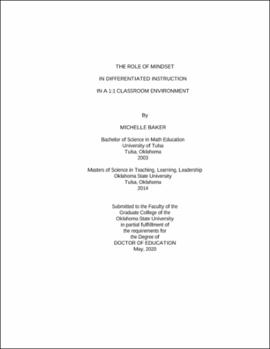| dc.contributor.advisor | Harris, Ed | |
| dc.contributor.author | Baker, Michelle | |
| dc.date.accessioned | 2020-09-09T20:49:19Z | |
| dc.date.available | 2020-09-09T20:49:19Z | |
| dc.date.issued | 2020-05 | |
| dc.identifier.uri | https://hdl.handle.net/11244/325454 | |
| dc.description.abstract | The purpose of this qualitative study is to explore the role of mindset regarding differentiated instruction in a 1:1 environment in a northeastern Oklahoma school district. The rationale for choosing the selected district was that the district was not brand new in the 1:1 initiative. All the teachers at the high school were asked to complete the Mindset Survey Quiz. From there, participants were selected based on their score on the quiz. Three teachers with a strong growth mindset and three teachers not with a strong growth mindset agreed to participate. Data included artifacts the school is using for the 1:1 instructional initiative, results of a mindset quiz from all teachers in the high school, two observations of each of the six teachers in the classroom, and interviews of six teachers. Two administrators were also interviewed for this study. Identification of mindset theory, espoused by Dweck (2006), and the concept map of differentiated instruction, espoused by Tomlinson and Allan (2000), occurred prior to conducting the study and provided a lens through which to present and analyze the school setting. Within mindset theory, a person is described to have either a fixed or a growth mindset. In the concept map of differentiated instruction, there are three main areas of differentiation: content, process, and product. Findings reveal that there is a difference in how teachers in this study with a growth mindset versus a fixed mindset incorporate differentiated instruction in the 1:1 environment. Those teachers having a growth mindset are completely on board with the technology integration. They are ready and willing to learn more in order to implement the technology as effectively as possible. The teachers having more of a fixed mindset did not always have that same outlook. A recommendation for future research is to explore the connection between mindset of district and site leadership and the design and implementation of a 1:1 instructional initiative. Another interesting area would be to research how district and site leadership work together to support teachers' work through the challenges of a 1:1 environment. | |
| dc.format | application/pdf | |
| dc.language | en_US | |
| dc.rights | Copyright is held by the author who has granted the Oklahoma State University Library the non-exclusive right to share this material in its institutional repository. Contact Digital Library Services at lib-dls@okstate.edu or 405-744-9161 for the permission policy on the use, reproduction or distribution of this material. | |
| dc.title | Role of mindset in differentiated instruction in a 1:1 classroom environment | |
| dc.contributor.committeeMember | Curry, Kathy | |
| dc.contributor.committeeMember | Utley, Juliana | |
| dc.contributor.committeeMember | Mania-Singer, Jackie | |
| osu.filename | Baker_okstate_0664D_16633.pdf | |
| osu.accesstype | Open Access | |
| dc.type.genre | Dissertation | |
| dc.type.material | Text | |
| dc.subject.keywords | 1:1 | |
| dc.subject.keywords | classroom | |
| dc.subject.keywords | differentiated instruction | |
| dc.subject.keywords | mindset | |
| dc.subject.keywords | teaching | |
| dc.subject.keywords | technology | |
| thesis.degree.discipline | School Administration | |
| thesis.degree.grantor | Oklahoma State University | |
